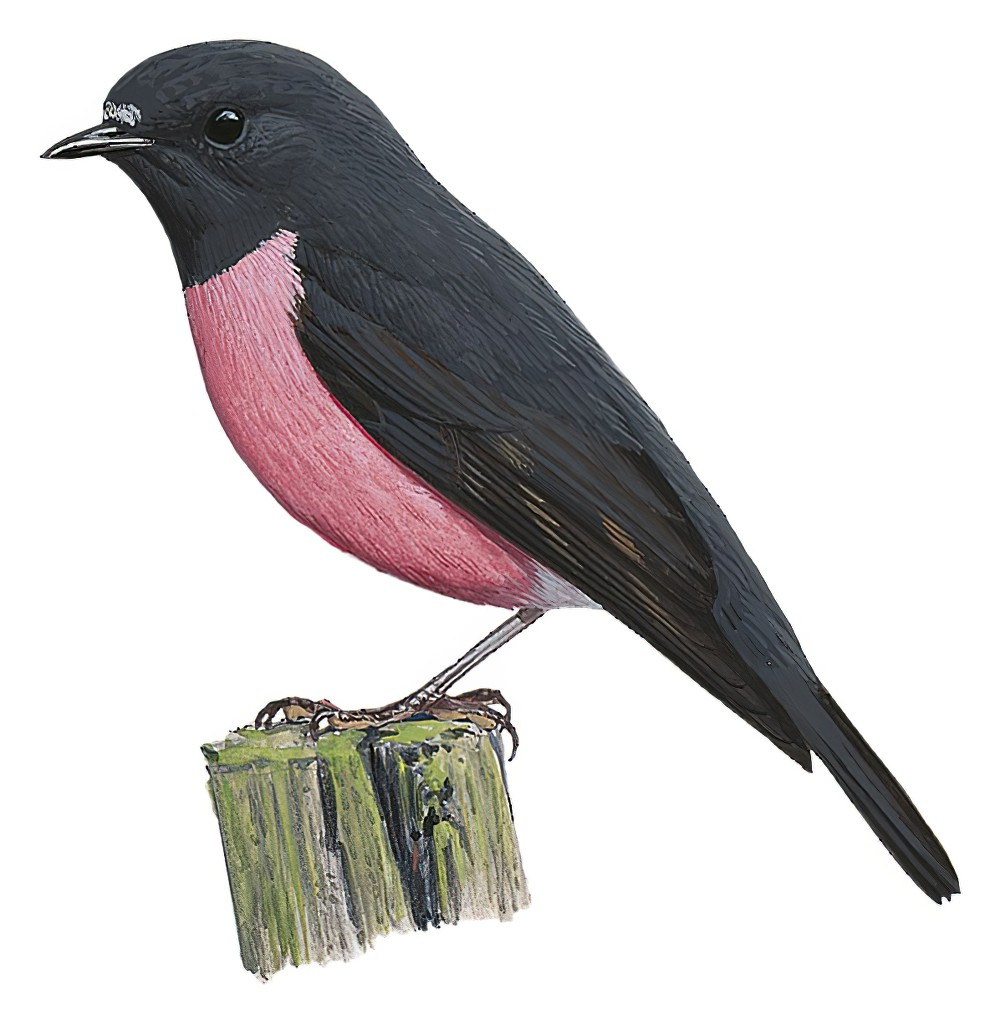Pink Robin / Petroica rodinogaster

Pink Robin
SCI Name:
Protonym: Saxicola Rodinogaster Ann.Gen.Sci.Phys. 2 p.341 pl.29
Taxonomy: Passeriformes / Petroicidae / Petroica
Taxonomy Code: pinrob1
Type Locality: Maria Island, Tasmania.
Author: Drapiez
Publish Year: 1819
IUCN Status: Least Concern
DEFINITIONS
PETROICA
(Petroicidae; Ϯ Norfolk Island Robin P. multicolor) Gr. πετρα petra rock, crag; οικος oikos dwelling < οικεω oikeō to inhabit; "PETROICA multicolor. Scarlet-breasted Robin. Family Sylviadæ. GENERIC CHARACTER. Bill slender, the sides compressed, the tip gradually bent, and beset with bristles at the base. Wings long; the first quill spurious; the second intermediate in length between the sixth and seventh. Tarsi elevated, the inner toe manifestly shorter than the external toe. Tail broad, even. ... Lewin, who wrote upon the spot, observes that although in some respects solitary, it frequents the abodes of man in winter, like the Robin; which it further resembles in its note. ... Mr. Caley mentions that he saw "this bird in November" (our European summer), "when far distant in the mountains, in the roughest part of the country I had then or since visited." Linn. Tr. 15. p. 245. Mr. Caley, moreover, as if perfectly aware of its natural affinities, names it the Australian Redstart." (Swainson 1830); "Petroica Swainson, 1830, Zool. Illustr., ser. 2, pt. 8, pl. 36 and text. Type, by monotypy, Muscicapa multicolor Gmelin." (Mayr in Peters 1986, XI, 562).
Var. Petroeca.
Synon. Belchera, Erythrodryas, Littlera, Miro, Myiomoira, Myioscopus, Nesomiro, Whiteornis.
rodinogaster
Gr. ῥοδινος rhodinos pink < ῥοδον rhodon rose; γαστηρ gastēr, γαστρος gastros belly.
SUBSPECIES
Pink Robin (rodinogaster)
SCI Name: Petroica rodinogaster rodinogaster
rodinogaster
Gr. ῥοδινος rhodinos pink < ῥοδον rhodon rose; γαστηρ gastēr, γαστρος gastros belly.
Pink Robin (inexpectata)
SCI Name: Petroica rodinogaster inexpectata
inexpecta / inexpectata / inexpectatum / inexpectatus / inexpectus / inexspectata / inexspectatus
L. inexspectatus unexpected, surprising, unlooked for < in- not; exspectatus awaited, expected < exspectare to await.
● “In view of the stability shown by Arremonops conirostris conirostris through a wide area, the appearance of this form so near the type-locality of that race is surprising and inexplicable” (Chapman 1914) (subsp. Arremonops conirostris).
● “It certainly was unexpected to find such a striking and hitherto unknown species on Guadalcanar, and this and the discovery of other new forms on the island shows that the ornithological exploration of Guadalcanar has hitherto been very imperfect” (Hartert 1929) (Guadalcanaria).
● “et necata inexpectatum nobis gaudium dedit novae speciei, ante nunquam visae” (Forster 1844) (Pterodroma).
● "Named both for the unexpected nature of its distribution, being restricted to two provinces of Ghana, and the fact that there are no obvious geographic barriers that separate it from two other members of the genus" (Voelker et al. 2016) (subsp. Stiphrornis erythrothorax).
● “On examining a large series of birdskins collected in the northern parts of Celebes and presented to the Leyden Museum by S. C. I. W. van Musschenbroek, Esq., I was quite astonished to find, that there exists in the Minahassa, beside Strix [= Tyto ] Rosenbergii, another large species of Barn-owl, very different as well from Strix Rosenbergii as from all the other known species” (Schlegel 1879) (Tyto).
UPPERCASE: current genus
Uppercase first letter: generic synonym
● and ● See: generic homonyms
lowercase: species and subspecies
●: early names, variants, mispellings
‡: extinct
†: type species
Gr.: ancient Greek
L.: Latin
<: derived from
syn: synonym of
/: separates historical and modern geographic names
ex: based on
TL: type locality
OD: original diagnosis (genus) or original description (species)












